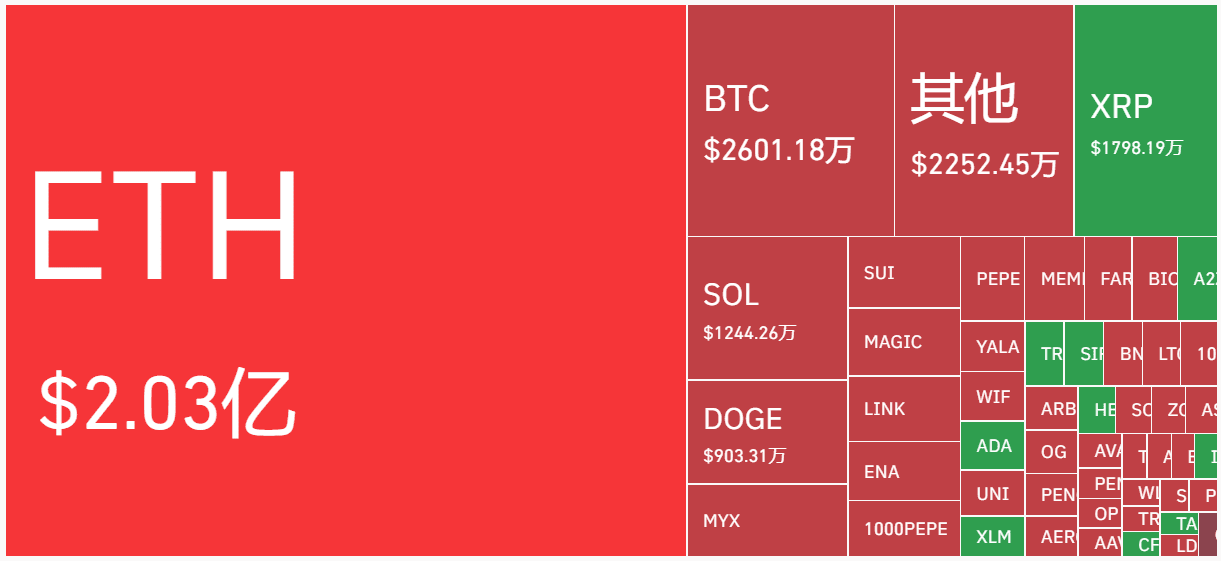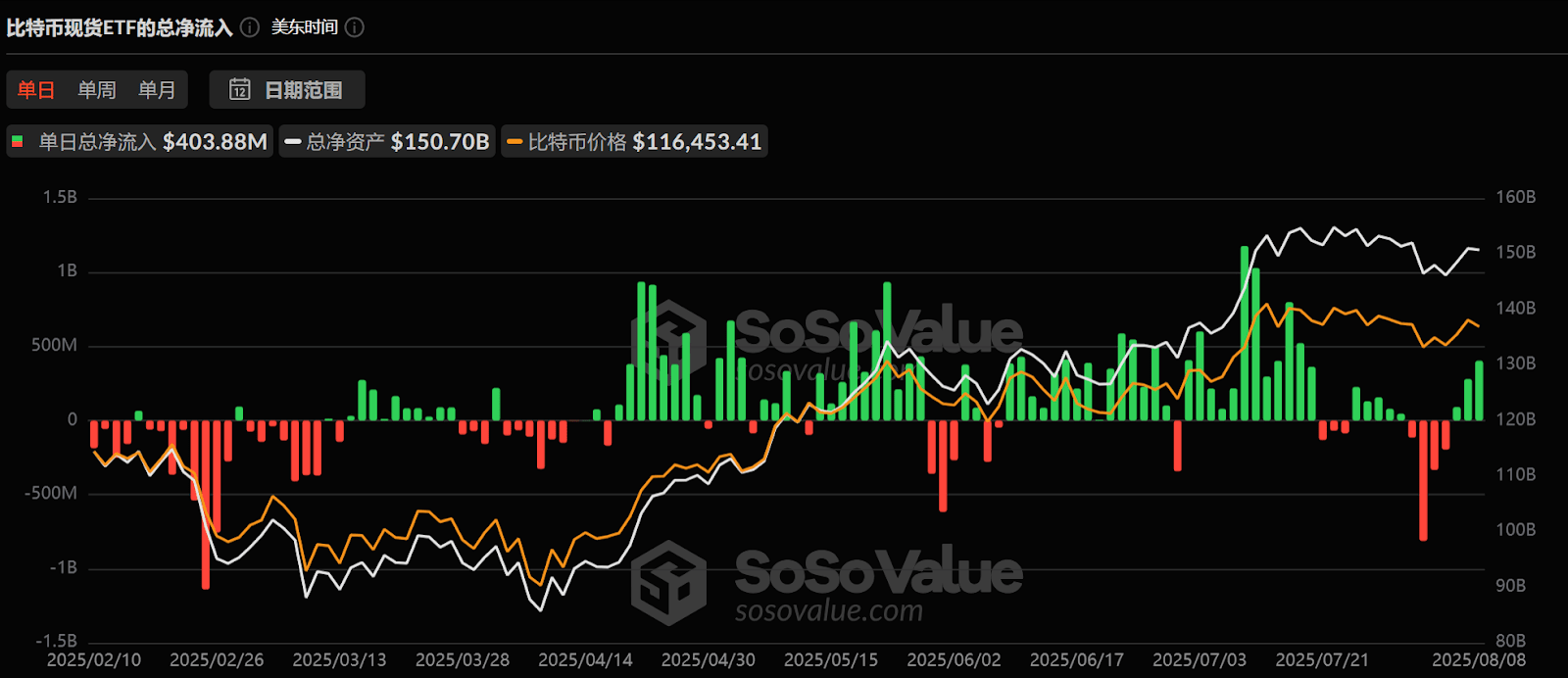Author | Ding Dong, Odaily Planet Daily
The crypto market is surging, with Ethereum leading this round of accelerated trends.
In the past 48 hours, ETH has strongly broken through the psychological barrier of $4,000, peaking at $4,200 and currently trading at $4,194, marking a new high in 45 months (since December 2021). Starting from a low of $1,385 on April 9, ETH has accumulated an increase of over 300%, with a single-month increase of 65% in July alone—significantly outperforming most altcoins and becoming a core target for capital absorption.
In contrast, Bitcoin's performance has been relatively weak, currently oscillating between $112,000 and $119,000, now reported at $117,200. Solana has rebounded from its low of $155.8 on August 3 to around $180, showing decent performance in the past two days. The altcoin sector is fully activated, with frequent positive news driving market sentiment, signaling that the 'altcoin season' is brewing.
In terms of liquidation data, the total amount of liquidations in the past 24 hours was $362 million; among them, long positions accounted for $78.14 million, while short positions accounted for $286 million, with ETH alone contributing $203 million to the liquidation scale; the largest single liquidation occurred on OKX ETH-USDT-SWAP, amounting to as much as $10.6284 million.

In terms of capital flows, the Bitcoin spot ETF turned from net outflow to net inflow after four consecutive days of net outflow; the Ethereum spot ETF also ended its two-day net outflow trend, recording net inflows for four consecutive days, indicating that funds are rapidly returning to the crypto market.


Macro catalysts: Trump's executive order and bearish sentiment clearance
On August 7, Trump's executive order officially allowed 401(k) pension plans to embrace cryptocurrencies, private equity, real estate, and other alternative assets for the first time. With a fund pool of up to $9 trillion, if even 2% is allocated to crypto assets, it could theoretically bring $170 billion in incremental growth—enough to leverage the entire spot ETF market. Although the policy will take months or even years to implement, its symbolic significance is enough to ignite market imagination. (See detailed report: Cryptocurrencies officially enter U.S. pension packages, the largest incremental entrance opens up).
On the same day, the equal tariff executive order officially took effect, imposing tariffs of 15% to 41% on imported goods from 67 trade partners, as the long-standing risk boot drops, bearish sentiments gradually digest.
Federal Reserve policy shift: Rate cut expectations heat up
San Francisco Fed President Daly bluntly stated that considering the weakening labor market and the limited inflation pressure from tariffs, the rate cut window is approaching, and the Fed may cut rates by 25 basis points in September or December; if the labor market deteriorates further, there may be more rate cuts.
On Thursday, Trump nominated Milan, chairman of the White House Council of Economic Advisers, to become a member of the Federal Reserve Board. Analysts generally believe that, as the architect of the tariff policy, Milan's appointment may lead the Fed's policies to become more dovish and put pressure on Powell for rate cuts.
Investment banks' analyses have converged: tariffs have pushed the trade-weighted average tax rate close to 20%, and this cost shock will erode corporate profits, weaken household purchasing power, and may force the Federal Reserve to act early in the fall. Institutions like Fidelity International and Berenberg Bank have even warned that if the policy response is slow, the 'lag effect' of 2021-2022 may repeat.
Capital Trends: Institutions accelerate their layout
Michael Saylor, Executive Chairman of Strategy (formerly MicroStrategy), stated that Trump's gold tariff will 'catalyze a new wave of institutional adoption of Bitcoin.' This is not just a confidence shout, but a reinforcement of the 'digital gold' narrative.
Michael Martin, head of the Ava Labs incubator Codebase, expects that by 2025, venture capital firms will invest up to $25 billion in crypto startups, driven by a perfect storm of favorable factors, including Circle's IPO, market recovery, Stripe's acquisition of Privy, Wall Street's increased focus on blockchain, and clarification of regulatory rules.
This year's capital flow has already hinted at the prelude to this storm. Martin pointed out that $13.2 billion has poured into crypto project financing so far this year, up 40% from the total for last year, and is expected to surpass PitchBook's forecast of $18 billion. However, he also reminded that if the performances of listed companies like Circle and Coinbase fall short of expectations, or if the macro environment worsens due to tariff policies, the pace of capital deployment may slow.
On-chain data: Multiple sectors rise together
On-chain metrics are also telling a recovery story. According to DappRadar data, the total locked value of DeFi protocols reached a historic high of $270 billion in July, a month-on-month increase of 30%. Tokenized stocks became a highlight of growth, with the number of active wallets surging from about 1,600 to over 90,000, and market value increasing by 220%.
During the same period, NFT trading volume grew by 96% month-on-month to $530 million, with approximately 3.85 million daily active wallets interacting with NFT DApps, slightly higher than DeFi. Despite the market warming in July, NFT trading volume still lags behind the peak in 2021.
Stablecoins continue to play a cornerstone role in market liquidity. The total circulation reached a historic high of $265 billion, with a growth rate of 5% over the past 30 days. Although it has not exploded with double digits as at the beginning of the year, this rebound in a backdrop of continuous slow growth indicates that funds are beginning to re-settle on-chain, waiting for the next peak.
Tracking recent events of the three major mainstream assets
According to on-chain analyst Yu Jin's disclosed data, since July 10, over 1.035 million ETH (worth approximately $4.167 billion) has been accumulated by multiple unknown whales/institutions through exchanges or institutional business platforms. Most of the ETH stored in these addresses is likely owned by institutions or U.S. companies doing ETH reserves (not including SBET addresses), with an average acquisition price of about $3,546.
The address of Sharplink Gaming has been traced. It currently holds a total of 532,914 ETH, worth $2.07 billion. On August 7, SharpLink announced that it had raised $200 million through a stock offering at $19.5 per share, with new funds intended to expand the Ethereum treasury. Following its previous pace, a new round of large buy orders is already on the way.
The story of Solana is somewhat different. The Solana Digital Asset Treasury Company, led by Joe McCann, originally planned to go public through a merger with Gores Holdings X's SPAC, raising up to $1.5 billion. However, this plan was abruptly halted recently, with no reason disclosed. Previous reports indicated that McCann's hedge fund Asymmetric had incurred nearly 80% losses this year, leading to market speculation: has the capital environment changed, or has the team's strategy shifted?
Altcoin tracking: Four stories worth paying attention to
Ripple (XRP): Six-year lawsuit comes to an end
The tug-of-war between XRP and the SEC has finally ended. Both parties have jointly withdrawn their appeals in the Second Circuit Court and will each bear their own litigation costs. This means that the ruling made by Judge Analisa Torres in 2023 officially takes effect: secondary market transactions do not constitute securities transactions, but large sales to institutions are illegal securities offerings. Ripple was fined $125 million and permanently banned from future violations. Related reading references (Over 70% increase in July, market value surpassing Pepsi and BlackRock, how XRP's 'anti-dip quality' is forged?)
Ripple CEO Brad Garlinghouse stated that the company will completely end this legal dispute and focus on more important things—building the 'value internet.' Meanwhile, Ripple's USD stablecoin RLUSD saw its supply surpass $600 million in July, a month-on-month increase of 32%, with a trading volume of $3.3 billion, hitting a historical high.
Digital Wealth Partners Management, LLC (DWP Management) also announced that since April, its series of private investment funds have raised approximately $200 million. As a private fund manager accepting physical digital asset investments, all physical contributions have been completed in XRP so far.
Ethena (ENA): Stabilizing confidence through buybacks
On July 21, Ethena Labs announced a $360 million PIPE (Private Investment in Public Equity) deal with stablecoin issuer StablecoinX, which plans to go public on NASDAQ under the ticker 'USDE' (the same name as Ethena's stablecoin USDe). Meanwhile, the Ethena Foundation launched a $260 million ENA token buyback program, expected to invest about $5 million daily over the next six weeks to establish ENA reserves. Related reading references (ENA's 'Confidence Game': $260 million buyback stabilizes price, $360 million blood transfusion supports StablecoinX's sprint to IPO).
DeFiLlama data shows that Ethena's synthetic stablecoin USDe has reached a market cap of $9.293 billion, an increase of 75.13% over the past month. USDe is currently the third largest stablecoin by market cap, behind USDT and USDC.
Chainlink (LINK): Locking in income on-chain
Chainlink announced the launch of Chainlink Reserve, a strategic on-chain reserve for LINK tokens, which plans to convert user fees and on-chain service fees from enterprise integrations into LINK tokens to support the long-term sustainable growth of the Chainlink network, which also means a long-term and continuous buyback plan.
Sergey Nazarov, co-founder of Chainlink, stated that the market's demand for Chainlink has generated hundreds of millions of dollars in revenue for the project, most of which comes from large enterprises. This reserve has already accumulated over $1 million in LINK tokens at launch, and will continue to grow in the future.
BounceBit (BB): A new play in CeDeFi
BounceBit has partnered with Wall Street asset management giant Franklin Templeton to launch a new product BB Prime, while simultaneously starting a token buyback program. This product integrates Franklin Templeton's tokenized money market fund, creating a CeDeFi structured product combining basis arbitrage and treasury yield. This tokenized fund belongs to the BENJI product series, which will serve as collateral and settlement tools within investment strategies. Through this approach, investors can not only obtain the underlying treasury rate yields but also add other sources of income. The announced BB token buyback plan is supported by over $10 million in protocol revenue and aims to strengthen the long-term value support of the token.
Overall, this rebound is fueled by macro policies, supported by on-chain data, and propelled by capital sentiment. Whether it is ETH's rapid breakthrough or the collective warming of the altcoin sector, the market seems to be accelerating toward a familiar yet exciting rhythm.



